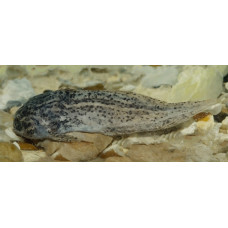Latin name
Liparis liparis
Other name
Striped seasnail, seasnail.
Identification
The body of the common seasnail is elongated, compressed at the sides (especially at the rear). Head is broad, somewhat flattened. Two nostrils on each side of the snout. The body is bare, covered with translucent thin skin. Underneath the skin is a layer of loose connective tissue, which makes the skin supple and gives the fish a jelly-like appearance. The swim bladder is absent. The sucker is much larger than the diameter of the eye.
Features of fish fins
The dorsal fin of these fishes is very long and ends at the caudal fin. The base of the dorsal fin is very long. There are 33-35 rays in the dorsal fin. The anterior rays of the dorsal fin are shortened. The anal fin is slightly shorter than the dorsal fin and is attached to the caudal fin. Pectoral fin with a broad base and a notch in the lower part. The pelvic fins are modified into a large sucking disc. The dorsal and anal fins overlap the caudal fin.
Fish colouring
The coloration of the common seasnail is dark brown on the top of the body and much lighter on the underside. The body is covered with stripes and spots of a darker brown color than the main background.
Distribution
This species is distributed in the North Atlantic and adjacent waters of the Arctic Ocean off Europe, Iceland, Svalbard and Greenland, south to the English Channel; Baltic Sea. In Russian waters, it is known from the Barents and White Seas, and is found in the Kara and Laptev Seas, near Novaya Zemlya and the Novosibirsk Islands.
Habitat
It is a bottom dwelling, slow moving fish. It lives in the coastal zone, at depths up to 100-300 meters. In the North Sea it inhabits muddy and sandy substrates, in other areas it sometimes inhabits rocky substrates. Fish are found in both positive and negative water temperatures.
Size
The maximum body length of the Common seasnail is 15 cm.
Behavior
The larvae of these fish initially live a pelagic lifestyle and gradually sink to the bottom as they grow older.
Food and feeding habits
The common seasnail feeds mainly on small crustaceans (shrimps, crabs, amphipods), less often on fish and polychaete worms.
Reproduction
In the southern parts of its range it spawns in December-February, in the north it breeds in early spring. Eggs are transparent, benthic, laid on colonies of marine polyps and underwater vegetation. The diameter of the eggs is 1.4-1.5 millimeters. Larvae emerge 6-8 weeks after fertilization of the eggs.
Fishing
This species is not commercially important.
Relationship with a person
Harmless.
| Classification | |
| Phylum | Chordata |
| Class | Actinopterygii |
| Squad | Perciformes |
| Family | Liparidae |
| Genus | Liparis |
| Species | L. liparis |
| Features | |
| Conservation status | Least Concern |
| Habitat | Bottom |
| Life span, years | No information |
| Maximum body weight, kg | No information |
| Maximum length, cm | 15 |
| Sailing speed, m/s | No information |
| Threat to people | Edible |
| Way of eating | Predator |
Common seasnail
Tags: common seasnail

